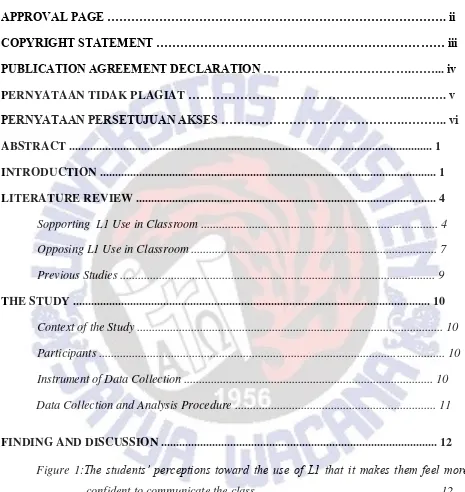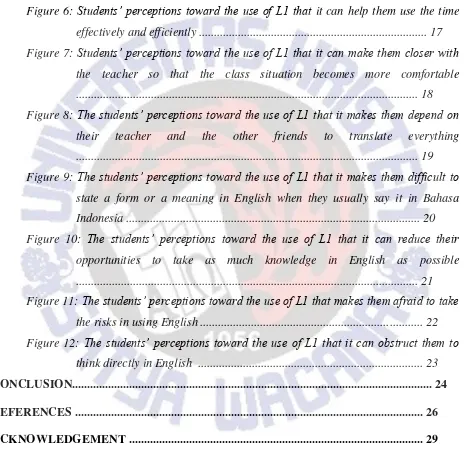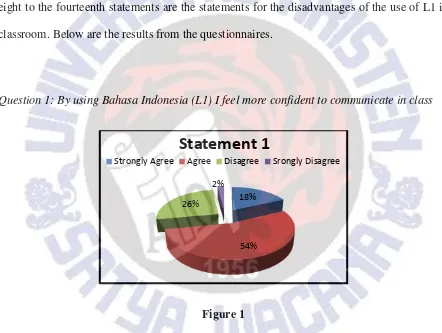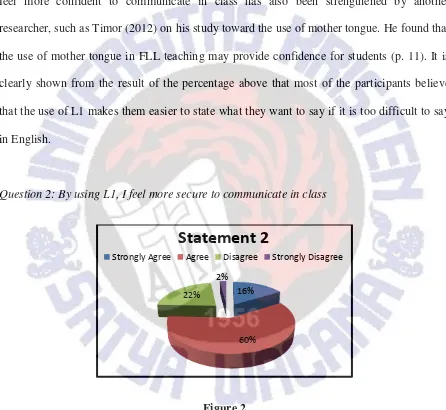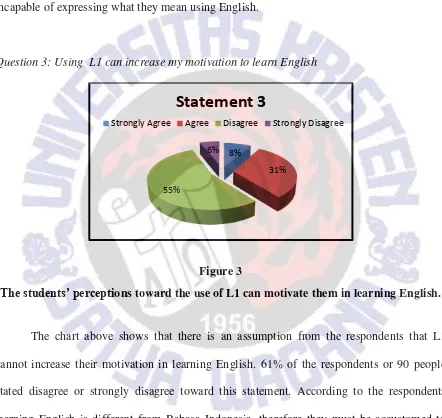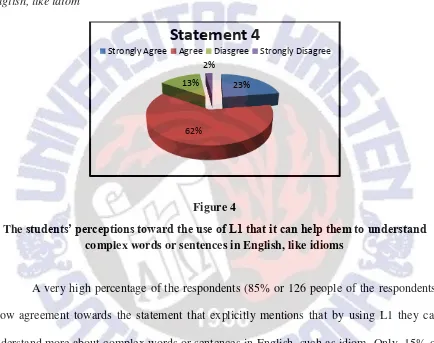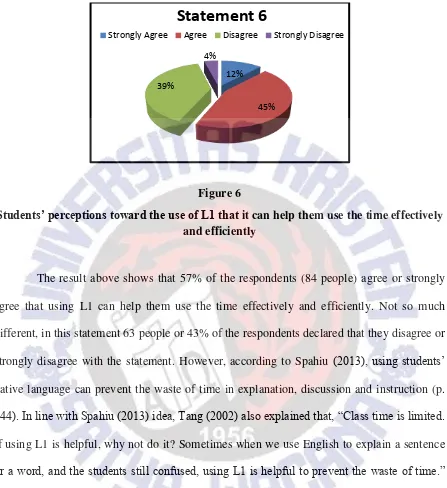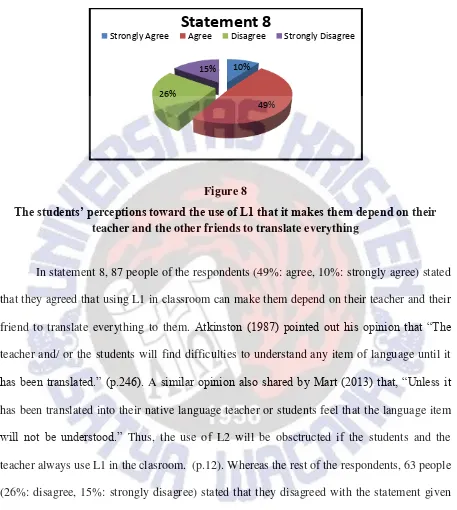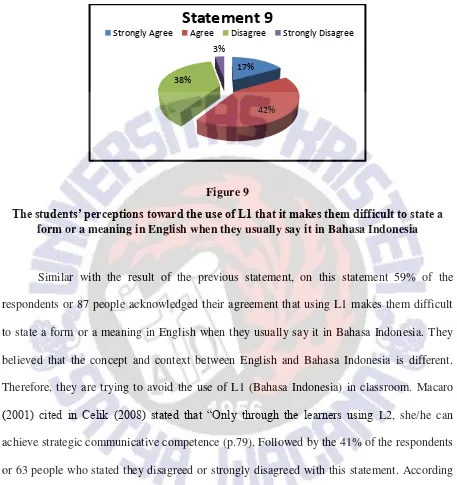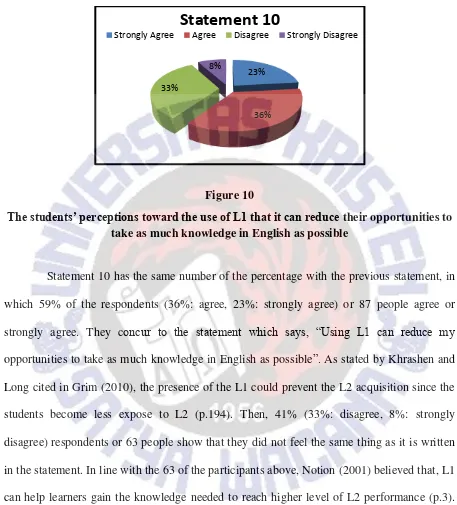Advanced Students’ Perceptions towards the Use of L1 in English
Classroom
THESIS
Submitted in Partial Fulfillment of the Requirements for the Degree of
Sarjana Pendidikan
Miravenstin Rihulay 112010060
ENGLISH TEACHER EDUCATION PROGRAM FACULTY OF LANGUAGE AND LITERATURE SATYA WACANA CHRISTIAN UNIVERSITY
i
Advanced
Students’ Perceptions toward
s the Use of L1 in English
Classroom
THESIS
Submitted in Partial Fulfillment of the Requirements for the Degree of
Sarjana Pendidikan
Miravenstin Rihulay 112010060
ENGLISH TEACHER EDUCATION PROGRAM FACULTY OF LANGUAGE AND LITERATURE SATYA WACANA CHRISTIAN UNIVERSITY
vii
Data Collection and Analysis Procedure ... 11
FINDING AND DISCUSSION ... 12
Figure 1:The students’ perceptions toward the use of L1 that it makes them feel more confident to communicate the class ... 12
Figure 2: The students’ perceptions toward the use of L1 that it makes them feel more secure to communicate in class ... 13
viii
Figure 4: The students’ perceptions toward the use of L1 that it can help them to
understand complex words or sentences in English, like idiom ... 15
Figure 5: The students’ perceptions toward the use of L1 that it helps them to express their point/idea, especially when they do not know how to say it using English ... 16
Figure 6: Students’ perceptions toward the use of L1 that it can help them use the time effectively and efficiently ... 17
Figure 7: Students’ perceptions toward the use of L1 that it can make them closer with the teacher so that the class situation becomes more comfortable ... 18
Figure 8: The students’ perceptions toward the use of L1 that it makes them depend on their teacher and the other friends to translate everything ... 19
Figure 9: The students’ perceptions toward the use of L1 that it makes them difficult to state a form or a meaning in English when they usually say it in Bahasa Indonesia ... 20
Figure 10: The students’ perceptions toward the use of L1 that it can reduce their opportunities to take as much knowledge in English as possible ... 21
Figure 11: The students’ perceptions toward the use of L1 that makes them afraid to take the risks in using English ... 22
Figure 12: The students’ perceptions toward the use of L1 that it can obstruct them to think directly in English ... 23
CONCLUSION... 24
REFERENCES ... 26
ACKNOWLEDGEMENT ... 29
1
ADAVANCED STUDENTS’ PERCEPTIONS TOWARDS THE USE OF L1 IN ENGLISH CLASSROOM
Miravenstin Rihulay
Abstract
There have always been contradicting views about whether or not to use the L1 of the students in English classroom. Many studies (Al-Sharaeai, 2012; Cook, 2001; Grim, 2010; Miles, 2004; Tang, 2002) were conducted by some researchers to look for the perceptions of students and / or the teachers towards the use of their L1 in L2 class. They believed that it is useful and effective to use the L1 and some of them not. This study is aimed to investigate students’ perceptions towards the use of L1 in English classroom, especially for advanced level students. In this study, close-ended questionnaires were distributed to collect the data from 150 students of English Teacher Education Program, Faculty of Language and Literature, Satya Wacana Christian University, Salatiga. The students of academic year 2012, 2011, and 2010 were chosen as they have spent about three years and more in the faculty. There are 12 statements provided in the questionnaires and categorized into two aspects; the advantages and the disadvantages of the use of L1. The result showed that the majority of the students had positive perceptions as the advantages of the use of L1 that it can help them to express their ideas when they do not know how to say it in English. Then, as the disadvantages of the use of L1 the students believed that L1 can obstruct them to think directly in English.
Key Words: L1, L2, students’ perceptions, English classroom.
INTRODUCTION
2
Those who use L1 in teaching and learning process thought that it can help the students in understanding teachers’ explanation about L2 rules. To strengthen the
statement before, Tang (2002) on his study found that students and teachers in China prefer to use their L1 because it improves their comprehension of L2 concept and vocabulary (p.41). While those who oppose this issue thought that when L1 is used too widely in classroom teaching, it can prevent the students’ effort in understanding and
acquiring L2 in teaching and learning process (Grim, 2010. p. 194). Therefore, They believed L2 must be used dominantly in English classroom.
(Al-3
Sharaeai, 2012; Schweers, 1999; Tang, 2003) investigate about both teachers and students perspectives toward the use of L1 and the frequency of using L1 in classroom. Yet, there have not been many studies that examine about students’ perceptions toward
the use of L1 in English classroom, in advanced level.
Furthermore, this issue still becomes a discussion topic because people still curious whether L1 is worth keeping and have benefits for both teachers and students. However, we do not know whether it has negative or positive effect in the learning process and why does it used in the classroom.
Significance of the Study
I believe that by conducting this study, it could provide information of using L1 in classroom. This study also would be beneficial to the students and also the teacher since this study provide the knowledge, such as the purpose and the impact of using L1. Moreover, by conducting this study, I expect that this study can make students and teachers make a consideration in using L1 in L2 classroom.
Purpose of the Study
The aim of this study is to identify the students’ perceptions toward the use of L1 in classroom. The reason is because L1 is often seen as a distraction, which creates a hesitation whether it is useful to apply or not in L2 classroom.
Research Question
This study aimed to answer this following question:
4
LITERATURE REVIEW
Overview
The use of first language (L1) is very influential in teaching second language (L2). The influence in here leads to the students’ understanding in receiving the material and anything else. Therefore some teachers prefer to use L1 instead of L2 as a tool to facilitate the teaching of second language (Grim, 2010. p. 194). On the other hand, in learning about L2, the learners only need to use the target language itself (Cook, 2001. p. 409). The aim is to prevent the students’ dependency of using L1.
Those statements seem have led us to look deeper into some experts’ views about the use of L1 in L2 class. The following review of previous studies will explain why L1 cannot and can be used in teaching L2.
SUPPORTING L1 USE IN CLASSROOM
5
meaning, explain tasks and test, to explain grammar, etc.. At this point, Spahiu (2013, p. 244) pointed out that the use of students’ L1 is essential in explaining the idea of the L2
learning as well as the grammar. In addition, there are also some advantages of the use of L1 that we often find in the teaching and learning process in the classroom, such as it can makes the students feel more confident and feel secure to communicate in the class. This idea is strengthened by some researchers, such as Spahiu (2013) and Schweers (1999). Sphaiu (2013) in his research declared that “Native language helps the students feel less stressful” (p. 246). Likewise, Schweers (1999) also stated that “Starting with the L1 provides a sense of security and validated the learners’ lived experiences, allowing them to express themselves.” (p. 7).
The function of L1 in language learning as media to give instruction is also support by Spahiu, which is said that the use of L1 in classroom offers a better possibility to give instruction more effectively (p. 246). Moreover, in supporting the statement L1 role in helping the students to understand more about L2, Notion (2001) said that L1 can facilitate the learners in gaining the knowledge in learning the second language (p. 3). Shcweers (1999) in his research about using Spanish in English class also stated that, “using L1 (Spanish) has led to the positive attitudes toward the process of learning English and better yet, encourages students to learn more English.” (p.13)
6
situation becomes more comfortable. Grim (2010) supported this idea by saying that, using L1 can create a sense of closeness between the students and the teacher either to show understanding or to create a friendly rapport (p.197). Second, it can prevent the waste of time in teaching and learning process. Tang (2002) also explained that, “Class time is limited. If using L1 is helpful, why not do it? Sometimes when we use English to explain a sentence or a word, and the students still confused, using L1 is helpful to prevent the waste of time.” (p.39)
In doing some activities in the classroom, especially when explaining teaching materials, there must have been new or difficult words. Consequently, L1 is used to prevent any misunderstanding between teacher and students. Again, Spahiu conveyed that the students prefer to translate difficult context and words for the sake of justifying the use of L1 in the classroom for teaching and learning the target language (p. 246). Xu (1993) as cited in Khresheh (2012), explained that “L1 is sometimes effective to explain difficult word”, for example when the word ‘electricity’ is
presented for the first time. Some students may have difficulties to understand its English definition, so it is effective to use L1 (p. 82).
7 OPPOSING L1 USE IN CLASSROOM
Compared to the previous opinions that agree with the use of L1 in classroom, there are also arguments revealed about the rejection of L1 use in classroom. Using L1 in classroom can inhibit students’ understanding in a process of learning the target language (L2). This is happen because teacher and students commonly use the L1 in the classroom. Whereas, in learning L2 the use of target language in the classroom itself should be used more dominantly in order to achieve the goals of L2 learning process. According to Schweers (1999), “English should be the primary vehicle of communication in the English classroom.” (p.9).
Similar with the previous statement, Schweers also wants to emphasize that in second language learning, the target language should be used to communicate and interact. This statement also supported by Allwright (1979) cited in Harmer (2007), he explained that the best way to learn about a language is by using the language itself (p.51). It means that when the learners want to learn English they should apply English as a medium of learning in the classroom. Harmer (2001) also stated that the overuse of L1 restricts the students’ exposure to the target language
8
1.) Unless it has been translated into their native language teachers or students feel that the language items will not be understood.
2.) Although students have the ability to express what they mean in the target language, they will speak to the teacher in their native language.
3.) Students will fail to realize the importance of the second language. (p.9)
The same idea is also avowed by Atkinson (1987) cited in Kavari (2014) that the following problems of over using L1:
1. “The teacher and / or the students begin to feel that they have not ‘really’ u
understood any item of language until it has been translated.
2. The teacher and / or the students fail to observe the distinctions between equivalence of form, semantic equivalence, and pragmatic features, and thus oversimplify to the point of using crude and inaccurate translation.
3. Students speak to the teacher in the mother tongue as a matter of course, even when they quite capable of expressing what they mean.
4. Students fail to realize that during many activities in the classroom it is essential that they use only English.” (p.209).
9
Previous Studies
The first study is conduct by Richard Miles about Evaluating the Use of L1 in the English Language Classroom by Japanese students. In his reasearch he founnd out two points about L1. First, using L1 in the classroom does not hinder learning L2. Second, L1 has a facilitating role to play in the classroom and can actually help learning L2. He proved it by shown one of the result that the students speaking skills showed significantly higher improvement due to the confidence factor. Thus, L1 use helped to foster this confidence.
The second by Pembayun Pujiastuti (2013) entitle Students’ of L1: A Study on Advance Grammar Students’ Perspectives. The result of her study answered the
research questions by analyzing these three themes. The first theme was about students‟ attitudes toward L1 use. The finding of this theme asserted that the majority of the participants welcomed the use of L1 in the classroom although they had been considered as the advanced students. They realized that L1 gave some benefit for them, such as 1) L1 became a communicative strategy; 2) L1 gave sense of security for students. The second theme was about students’ preferred frequency of L1 use. It indicates that almost all the participants wanted the existence of L1 in classroom. The third theme was about students’
10
THE STUDY
Context of the Study
This study is about the perceptions of advanced level students of using L1 in the classroom. This study is conducted in English Teacher Education Program, Faculty of Language and Literature, Satya Wacana Christian University. The reason why I chose advanced students is because sometimes L1 is often used in advanced classes. Besides, many previous studies had found out that the students who still want the existence of L1 is the beginner level students. Therefore, I was curious about the finding if the study was conducted with advanced level students as the participants. Thus, I wanted to know the perceptions of the advanced level students’ towards the use L1 in English classroom.
Participants
The participants of the study were 150 students of English Teacher Education Program, Faculty of Language and Literature, Satya Wacana Christian University who has been learning English for 3 years or more such as, the students whose academic years were, 2012, 2011, and 2010 in the faculty and they were selected randomly. Here, I consider those students because they had passed the basic and the intermediate courses available in the faculty.
Instrument of Data Collection
This study used close-ended questionnaire as the instrument data collection to investigate advanced level students’ perceptions toward the use of L1 in English
11
consists of 12 questions which divided into two parts. Question number 1-7 is about the advantages of the use of L1, whereas question number 8-12 s about the disadvantages of the use of L1.
Data Collection and Analysis Procedure
In collecting the data, the questionnaires were distributed to the advanced level students. Before that, I conducted the piloting to make sure that all items in the questionnaire were already clear and understandable, as well as to prevent the participants’ confusion while filling the questionnaire. After piloting the study, I
distributed the fixed questionnaires to the participants which are different from the participants in the piloting process. There were 160 questionnaires that I distributed in order to prevent if some of the participants did not return the questionnaire or did not complete the questionnaire correctly which would make the data invalid. After collecting the questionnaire that I distributed, I picked 150 questionnaires according to the accuracy of the questionnaire to get the valid data to analyze.
12
FINDING AND DISCUSSION
In this part, the findings from the questionnaire are described based on two categories of the use of L1 in English class, which are the advantages and disadvantages of the use of L1. Before analyzing the two categories, each statement of the questionnaire will be analyzed first to see the students’ perceptions toward the statements in the questionnaire. There were
12 items in the questionnaire that the students should answer. The first until the seventh statements on the questionnaire are the statements for the advantages of the use of L1 and the eight to the fourteenth statements are the statements for the disadvantages of the use of L1 in classroom. Below are the results from the questionnaires.
Question 1: By using Bahasa Indonesia (L1) I feel more confident to communicate in class
Figure 1
The students’ perceptions toward the use of L1 that it makes them feel more confident to communicate the class.
From the result above, it can be seen that the majority of the respondents (72% or 108 people; either strongly agreed or agreed) believed that the use of L1 may enhance their confidence to communicate in class. Then only 28% or 42 people of the respondents showed that they disagree or strongly disagree with this statement. Sphaiu (2013) in his research
13
stated that “Native language helps the students feel less stressful” (p. 246). Less stressful here
means that the students will not feel afraid to make mistake, like speak up or communicate in the classroom. Those students who agree that the using of L1 in classroom believed that by using L1 in teaching and learning process, it would help them in enriching their comprehension towards English itself. The idea of the use of L1 that can make the students feel more confident to communicate in class has also been strengthened by another researcher, such as Timor (2012) on his study toward the use of mother tongue. He found that the use of mother tongue in FLL teaching may provide confidence for students (p. 11). It is clearly shown from the result of the percentage above that most of the participants believe that the use of L1 makes them easier to state what they want to say if it is too difficult to say in English.
Question 2: By using L1, I feel more secure to communicate in class
Figure 2
The students’ perceptions toward the use of L1 that it makes them feel more secure to communicate in class.
Schweers (1999) stated that “Starting with the L1 provides a sense of security.” (p.
7). I suported the statement of Schweers (1999) as it is shown in the precentage above. A
14
respondents or 114 people) that using L1 makes them feel more secure to communicate in the class. According to Jadallah and Hassan (2011) cited in Kavari (2014), “L1 use gives a sense of security and helps learners to be stress free.” (p. 208). This statement does not vary much with the statement 1, which, the use of L1 itself makes the students to be stress free or it can decrease the students anxiety when they are interacting one each other and when they are incapable of expressing what they mean using English.
Question 3: Using L1 can increase my motivation to learn English
Figure 3
The students’ perceptions toward the use of L1 can motivate them in learning English.
The chart above shows that there is an assumption from the respondents that L1 cannot increase their motivation in learning English. 61% of the respondents or 90 people stated disagree or strongly disagree toward this statement. According to the respondents learning English is different from Bahasa Indonesia, therefore they must be accustomed to use English in order to be more motivated after knowing their mistakes. Meanwhile, the other 39% or 60 people of the respondents thought that using L1 can encourage them to learn English. They stated that if they used Bahasa Indonesia first, it will ease them to learn English. This statement is supported by Shcweers (1999) in his research about using Spanish
8%
31% 55%
6%
Statement 3
15
in English class found out that, “using L1 (Spanish) has led to the positive attitudes toward the process of learning English and better yet, encourages students to learn more English.”
(p.13)
Question 4: By using L1, I can understand more about complex words or sentences in
English, like idiom
Figure 4
The students’ perceptions toward the use of L1 that it can help them to understand complex words or sentences in English, like idioms
A very high percentage of the respondents (85% or 126 people of the respondents) show agreement towards the statement that explicitly mentions that by using L1 they can understand more about complex words or sentences in English, such as idiom. Only 15% of the respondents show disagreement toward this statement. As Xu (1993) cited in Khresheh (2012), explained that “L1 is sometimes effective to explain difficult word”, for example when the word ‘electricity’ is presented for the first time. Some students may have
difficulties to understand its English definition, so it is effective to use L1 (p. 82). In addition, Kovacic and Kirinic (2011) cited in Al-Shareai (2012) asserted in his research about teachers’ and students’ perceptions towards using Croatian (L1) in English for Specific Purpose (ESP)
23%
62% 13%
2%
Statement 4
16
class whether it should be used or should be avoided that, the use of first language is more important in explaining difficult concept (p. 17).
Question 5: The use of L1 helps me to express my point/idea, especially when I do not know
how to say it using English
Chart 5
The students’ perceptions toward the use of L1 that it helps them to express their point/idea, especially when they do not know how to say it using English
Almost the same result like the previous statement, in this statement 64% or 95 people stated that they agree or if the use of L1 helps them to express their point/idea, especially when they do not know how to say it using English. Similarly, the other respondents (29%) or 44 people confirmed that they absolutely agree with the statement. Salah (2011) cited in Kavari (2014) pointed out that, “students use their L1 to speak to the teacher when they cannot express what they mean using L2 .” (p. 209). Yacoub (2011) also believe that L1 can help teachers understand the questions that the students ask in L1 when they do not know how to express the question in English (p.12-17). Otherwise, only 1 (1%) respondent who stated absolute disagreement and the other 10 respondents (6%) disagreed with this statement.
17
Question 6: Using Bahasa Indonesia can help me use the time effectively and efficiently
Figure 6
Students’ perceptions toward the use of L1 that it can help them use the time effectively and efficiently
The result above shows that 57% of the respondents (84 people) agree or strongly agree that using L1 can help them use the time effectively and efficiently. Not so much different, in this statement 63 people or 43% of the respondents declared that they disagree or strongly disagree with the statement. However, according to Spahiu (2013), using students’ native language can prevent the waste of time in explanation, discussion and instruction (p. 244). In line with Spahiu (2013) idea, Tang (2002) also explained that, “Class time is limited.
If using L1 is helpful, why not do it? Sometimes when we use English to explain a sentence or a word, and the students still confused, using L1 is helpful to prevent the waste of time.”
(p.39)
12%
45% 39%
4%
Statement 6
18
Question 7: If I and my teacher use Bahasa Indonesia, it can make us closer so that the class
situation become more comfortable
Figure 7
Students’ perceptions toward the use of L1 that can make them feel closer with the teacher so that the class situation becomes more comfortable
The chart above shows that more than a half of the respondents (61% or 91 people of the respondents) feel closer with the teacher when they used L1 in class and also the class atmosphere becomes more comfortable. As supported by Grim (2010), using L1 can create a sense of closeness between the students and the teacher either to show understanding or to create a friendly rapport (p.197). Likewise, Al-Hinai (2011) also added that L1 can reduce learners’ anxiety and creates a more relaxing environment (p.208). Then, the rest 39% or 59
people of the respondents stated that they did not feel the same thing. In their view, they are expecting the teachers to use English (L2) more often since their priority is the target language (English).
12%
49% 35%
4%
Statement 7
19
Question 8: Using Bahasa Indonesia makes me will always depend on my teacher and the
other friends to translate everything first
Figure 8
The students’ perceptions toward the use of L1 that it makes them depend on their teacher and the other friends to translate everything
In statement 8, 87 people of the respondents (49%: agree, 10%: strongly agree) stated that they agreed that using L1 in classroom can make them depend on their teacher and their friend to translate everything to them. Atkinston (1987) pointed out his opinion that “The teacher and/ or the students will find difficulties to understand any item of language until it has been translated.” (p.246). A similar opinion also shared by Mart (2013) that, “Unless it
has been translated into their native language teacher or students feel that the language item will not be understood.” Thus, the use of L2 will be obsctructed if the students and the
teacher always use L1 in the clasroom. (p.12). Whereas the rest of the respondents, 63 people (26%: disagree, 15%: strongly disagree) stated that they disagreed with the statement given because sometimes they feel that if the lesson was delivered using L1 (Bahasa Indonesia) it will ease them to understand the point of the lesson, so they will be more motivated to learn English.
20
Question 9: Using a form or meaning in Bahasa Indonesia makes me difficult to state it in
English
Figure 9
The students’ perceptions toward the use of L1 that it makes them difficult to state a form or a meaning in English when they usually say it in Bahasa Indonesia
Similar with the result of the previous statement, on this statement 59% of the respondents or 87 people acknowledged their agreement that using L1 makes them difficult to state a form or a meaning in English when they usually say it in Bahasa Indonesia. They believed that the concept and context between English and Bahasa Indonesia is different. Therefore, they are trying to avoid the use of L1 (Bahasa Indonesia) in classroom. Macaro (2001) cited in Celik (2008) stated that “Only through the learners using L2, she/he can
achieve strategic communicative competence (p.79). Followed by the 41% of the respondents or 63 people who stated they disagreed or strongly disagreed with this statement. According to them, through Bahasa Indonesia they will be easier to know and learn English.
17%
42% 38%
3%
Statement 9
21
Question 10: Using L1 can reduce my opportunities to take as much knowledge in English as
possible
Figure 10
The students’ perceptions toward the use of L1 that it can reduce their opportunities to take as much knowledge in English as possible
Statement 10 has the same number of the percentage with the previous statement, in which 59% of the respondents (36%: agree, 23%: strongly agree) or 87 people agree or strongly agree. They concur to the statement which says, “Using L1 can reduce my opportunities to take as much knowledge in English as possible”. As stated by Khrashen and Long cited in Grim (2010), the presence of the L1 could prevent the L2 acquisition since the students become less expose to L2 (p.194). Then, 41% (33%: disagree, 8%: strongly disagree) respondents or 63 people show that they did not feel the same thing as it is written in the statement. In line with the 63 of the participants above, Notion (2001) believed that, L1 can help learners gain the knowledge needed to reach higher level of L2 performance (p.3). Likewise, Tang (2002) also added that “Limited and judicious use of mother tongue in the
English classroom does not reduce students exposure to English, but rather can assist in the teaching and learning process.” (p.41).
23%
36% 33%
8%
Statement 10
22
Question 11: Using L1 makes me afraid to take the risks in using English
Figure 11
The students’ perceptions toward the use of L1 that makes them afraid to take the risks in using English
Unlike the result of the previous statement, the result of statement 11 shows a different pictures. 55% (total agree: 35% and strongly agree: 15%) of the respondents or 75 people believed that using L1 makes them afraid to take risks in using English. The reason that makes them afraid is because they already feel comfortable with the L1 that they used when they spoke altough they know how to speak English. This statement is supported by Mart (2013) who believed that students will speak in their mother tongue to express what they mean even when they can speak using English (p.12). Similarly, Atkinson (1987) cited in Kavari (2014) added, students speak to the teacher in the mother tongue as a matter of course, even when they quite capable of expressing what they mean (p.209). Then, the remaining 45% respondents (total disagree: 42% and strongly disagree: 8%) showed the otherwise. These respondents disagreed with the statement is not because they are afraid to speak using English, but they just avoid themselves from the mistakes.
23%
32% 38%
7%
Statement 11
23
Question 12: Using L1 can obstruct me to think directly in English
Figure 12
The students’ perceptions toward the use of L1 that it can obstruct them to think directly in English
In the last statement, 60% of the respondents (43%: agree, 17%: strongly agree) certain that the use of L1 can obstruct them to think directly in English. Choomthong (2014) believed that thinking in L1 can inhibit thinking directly in the target language (p.49). Previously, Choomthong had proved her statement in her study that she conducted in 2011. In her study, although it was found that high-ability students used L1 by translating the English sentence by adding the Thai passive marker, “Thùk” to see if the English passive voice construction and meaning were needed, they failed to apply the language use to other English passive voice usage or in other contexts. While the rest 40% respondents (34%: disagree, 6%: strongly disagree) showed disagreement toward the statement. They did not think that using L1 can obstruct them to think directly in English because they thought learning English will be easier if using Bahasa Indonesia first. For an instance, when they learned about complex words or ideas and grammar. Morahan (2009) stated that “Use of some L1 provides more times to practice L2 because understanding is achieved much more rapidly.”
17%
43% 34%
6%
Statement 12
24
CONLUSION
The twelve charts that had beem discussed previously showed the percentage of the students’ perceptions toward the use of L1 on its several advantages and disadvantages in its
use. Therefore, it can be said that the advanced students support the use of L1 because it helps them in learning English a lot. Based on the data collection, the writer found the highest four of students’ preferences regarding the use of L1 in the classroom. Their preferences are
the use of L1 in: 1) helping them to express their point/idea, especially when they do not know how to say it using English, 2) understand more about complex words or sentences in English, like idiom, 3) feel more secure to communicate in class, (4) and makes them feel more confident to communicate in class. This finding was equivalent with the previous study conducted by Morahan (2009), Miles (2004), Shareai (2012). Kavari (2014).
In this research, the writer also found that the majority of students perceived L1 as a beneficial thing. They believed that L1 will help them understand English better because they have different capabilities from one to another and by the use of L1, they can acquire and perform better in the classroom. This finding supports Miles (2004) who stated in his research that “L1 use in the English classroom does not hinder the learning of an L2, and actually facilitate it”. However, some of the respondents of this study also suggest that they
will not gain so much knowledge if the L1 is exposed. They prefer the maximum exposure to the English so they will not depend on the use of L1. They also believe that the use of English will increase their ability in acquiring the language.
25
26 References
Al-Sharaeai, W. A. (2012). Students’ Perspectives on the Use of L1 in English Classrooms (Unpublished Master’s Thesis). TESL Department, Iowa State University,
Ames, Iowa.
Celik, S. (2008). Opening The Door: An Examination of Mother Tongue Use in Foreign Language Classrooms. H. U. Journal of Edication, 34, 75-85.
Choomthong, D. (2014). Preparing Thai Students’ English for the ASEAN Economic
Community: Some Pedagogical Implication and Trends. Language Education and Acquisition Research Network (LEARN) Journl, 7 (1),
45-57.
Cook, V. (2001). Using the First Language in the Classroom. The Canadian Modern Language Review, 57(3), 402-423.
Dewi, S. K. (2006). The Students’ and Teachers’ Attitudes towards the Use of First
Language (L1): A Study of The English Department’s Speaking 1 Classes in
Trimester I – 2005/2006. English department, Faculty of Language and
Literature, Satya Wacana Christian University, Salatiga, Indonesia.
27
Kalanzadeh, GH.K., Hemti, F., Shahivand, Z., & Bakthiarvand, M. (2013). The Use Of EFL Students’ L1 in English Classes. The International Journal of Language
Learning and Applied Linguistics World (IJLLALW), 2 (2), 30-39.
Kavari, K. E. (2014). To use or not to use mother tongue in ELT classrooms, that is the Question. Spectrum: A Journal of Multidiciplinary Research (SAJMR), 3 (6), 206-2012.
Khresheh, A. (2012). Exploring When and Why to Use Arabic in Saudi Arabian EFL Classroom: Viewing L1 Use as Eclectic Technique. English Language Teaching, 5 (6), 78-87.
Kovacic, A., & Kirinic, V. (2011). To Use or Not to Use: First Language in Tertiary Instruction of English as a Foreign Language. 1st International Conference on Foreign Language Teaching and Applied Linguistics, Sarajevo, 150-159.
Mahmoudi, L. (2011). The Use of Persian in The EFL classroom – The Case of English Teaching and Learning at Pre-university Level in Iran. English Language Teaching, 4(1), 135-140.
Mart, C. T. (2013). The Facilitating Role of L1 in ESL Classes. International Journal of Academic Research in Business and Social Science, 3 (1), 9-14.
Miles, R. (2004.) Evaluating the use of L1 in the English language classroom. Unpublished master’s dissertation, University of Birmingham, UK.
Morahan, M. (2009). The Use of Students’ First Language (L1) in The Second Language (L2) Classroom. http://teflbootcamp.com/MorahanL2inL1class.pdf. Acces on May, 15th 2015 at 18:59.
28
Salah, N., & Farah, M. (2012). Examining the Use of Arabic in English Classes at the Primary Stage in Hebron Government Schools, Palestine: Teachers’ Perspective. AWEJ, 3(2), 400-436.
Schweers, W. (1999). Using L1 in the L2 Classroom. English Teaching Forum, 37(2), 6-13. Spahiu, I. (2013). Using Native Language in ESL Classroom. IJ-ELTS: International
Journal of English Language & Translation Studies, 1(2), 243-248.
Tang, J. (2002). Using L1 in the English Classroom. English Teaching Forum, 40(1), 36-43. Timor, T. (2012).Use of the Mother Tongue in Teaching a Foreign Languge. Language
Education in Asia, 3(10), 7-17.
29
ACKNOWLEDGEMENT
First and foremost, as a man full of weaknesses and limitations let me be thankful to my Lord and my Savior, Jesus Christ who always help me and equip me with wisdom and intelligence and with all the advantages that comes from him. Without Him, this thesis would not have been done.
I would also like to express my gratitude and deepest appreciation to my supervisor, Dr. Elizabeth Titik Murtisari, M.TransStud., PhD, who has guided and helped me patiently and kept encouraging me that I could give the best I had in my thesis. Furthermore, I would also like to thank my thesis examiner, Victoria Usadya Palupi, S.Pd., MA-ELT who have helped and shared her useful ideas to improve and enhance my thesis.
Thanks and gratitude I also dedicate special to my beloved parents, Ivony Rihulay and David Rihulay as well as my sisters and my brother, Eby, Grace, and Theo, who always support and motivate me, give advice and encouragement during my study. I am very grateful to have a family like you. I love you all!
In addition, I also want to give thanks to all my best friends who have helped me and boost my spirit in doing my thesis. Without their help, I might never finish thesis well. Additionally, thanks to all FLL family who has given me valuable lessons and experiences for my future. Without all of you I am nothing.
30
saya mengharapkan partisipasi teman-teman sekalian untuk mengisi kuesioner ini sebagai data penelitian saya. Atas bantuan, kesediaan waktu, dan kerjasamanya saya ucapkan terima kasih. * Bacalah pernyataan-pernyataan berikut dengan teliti dan berilah tanda cek () pada kolom yang
sesuai.
- SS : Sangat Setuju - S : Setuju
- TS :Tidak Setuju -STS: Sangat Tidak Setuju
No Pernyataan SS S TS STS
1. Dengan menggunakan Bahasa Indonesia (L1), saya merasa lebih percaya diri dalam berkomunikasi di kelas.
2. Dengan menggunakan Bahasa Indonesia, saya merasa lebih aman dalam berkomunikasi di kelas.
3. Dengan menggunakan Bahasa Indonesia, saya lebih termotivasi dalam belajar Bahasa Inggris.
4. Dengan menggunakan Bahasa Indonesia, saya dapat memahami lebih jelas tentang arti kata atau kalimat yang sulit dalam Bahasa Inggris, seperti idiom.
5. Penggunaan Bahasa Indonesia, dapat membantu saya dalam
mengutarakan maksud/ide khususnya ketika saya tidak tahu bagaimana mengungkapakannya dalam Bahasa Inggris.
6. Dengan menggunakan Bahasa Indonesia, maka waktu yang tersedia dapat digunakan secara efektif dan efisien.
7. Apabila saya dan guru saya menggunakan Bahasa Indonesia, itu dapat mendekatkan hubungan kami sehingga suasana kelas menjadi lebih nyaman.
8. Kebiasaan menggunakan Bahasa Indonesia, membuat saya akan selalu bergantung pada guru dan teman saya untuk menterjemahkan segala sesuatu terlebih dahulu.
9. Kebiasaan saya menggunakan suatu bentuk atau arti dalam Bahasa Indonesia, menyulitkan saya ketika harus mengungkapkan arti atau bentuk tersebut dalam Bahasa Inggris secara tepat.
10. Kebiasaan menggunakan Bahasa Indonesia mengurangi kesempatan saya untuk mendapat pengetahuan tentang Bahasa Inggris sebanyak mungkin.
31
mengambil resiko dalam menggunakan Bahasa Inggris.
12. Kebiasaan menggunakan Bahasa Indonesia menghambat saya untuk berpikir secara langsung dalam Bahasa Inggris.
NIM :
Lama belajar Bahasa Inggris :
